The MSI GT80 Titan Review: The Broadwell Gaming Laptop Your Desktop Envies
by Brett Howse on June 26, 2015 8:00 AM ESTSystem Performance
Intel’s Broadwell rollout has been fairly drawn out, with the first chip made on the 14nm process being Core M way back in October 2014. At CES, Intel launched the Broadwell-U processors which were 15-28 watt TDPs, but all dual-core. With Intel trying to make a bigger push into mobile, even the Atom processor got moved to 14nm before the quad-core Core parts, but finally as of June 2nd, Intel launched some quad-core laptop parts and a couple of desktop parts.
MSI sent along the latest update to the GT80 Titan which is powered by the Intel Core i7-5700HQ processor. As with any CPU update, Intel has made a few tweaks to the architecture which will gain a few percentage points in IPC, however this is in essence a die shrink on Haswell, so we have to keep expectations in check. What we have seen on the Broadwell-U line is better battery life, and a nice boost in performance by the processor being able to maintain higher turbo frequencies while keeping within its thermal envelope.
With a TDP of 47 watts, the i7-5700HQ, it will be interesting to compare how the Broadwell quad-core parts compare to Haswell. The i7-5700HQ has a base frequency of 2.7 GHz and a turbo of 3.5 GHz. There is not a perfectly comparable Haswell part that we have tested however the i7-4720HQ has been in several devices this year and has a slightly lower base of 2.6 GHz and a slightly higher turbo of 3.6 GHz which should make an interesting comparison.
I have put the GT80 Titan through our standard laptop workload, and picked some comparative devices. Take note that the Clevo P750ZM actually has an 88 watt desktop CPU inside. The MSI GT72 Dominator Pro has a 47 watt TDP and the same 3.5 GHz turbo frequency so it should be a great comparison for Haswell versus Broadwell. If you want to compare the GT80 Titan to any other laptop we have tested, please use our Notebook Bench.
PCMark
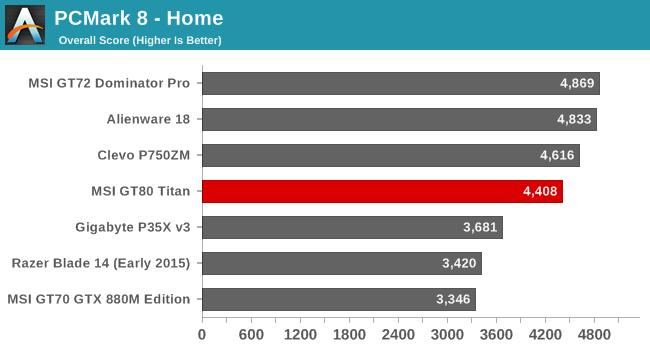
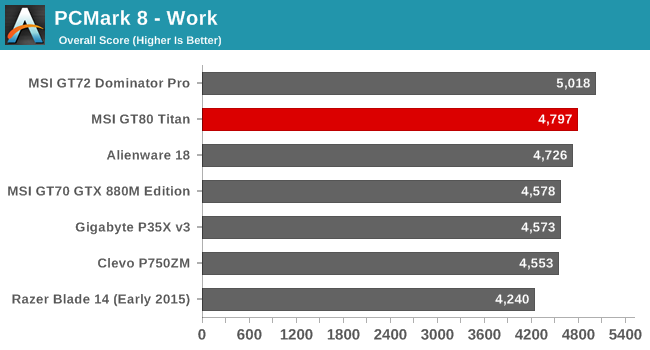
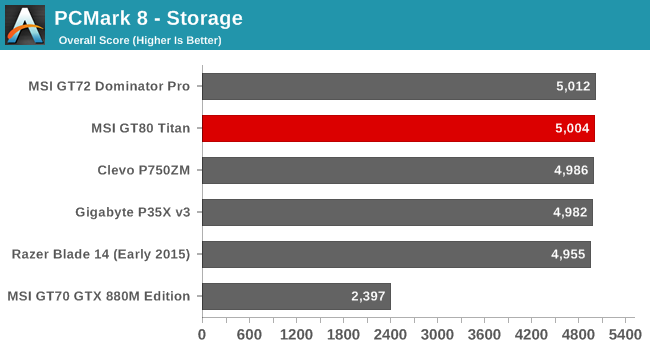
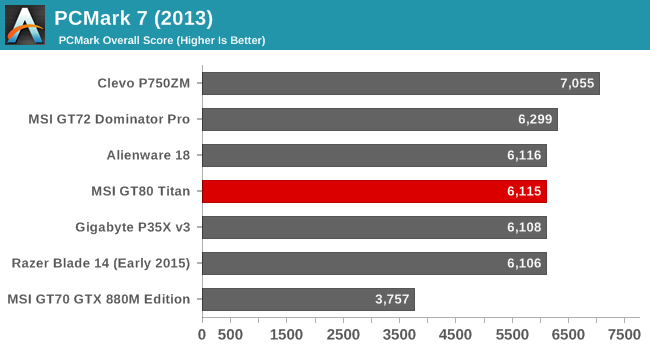
PCMark tries to simulate some real life workloads, with several different subtests for different sets of tests. It is not a pure CPU test, and also factors in memory, storage, and even display resolution. The GT80 does not outright win these tests however it is competitive. The two SSDs in RAID 0 help boost it to one of the higher storage scores, and for the target market the extra cost and loss of battery life of RAID 0 is fine. One thing to note is that the Creative test on PCMark 8 would fail to run on this device, so there was no score recorded for that test.
Cinebench
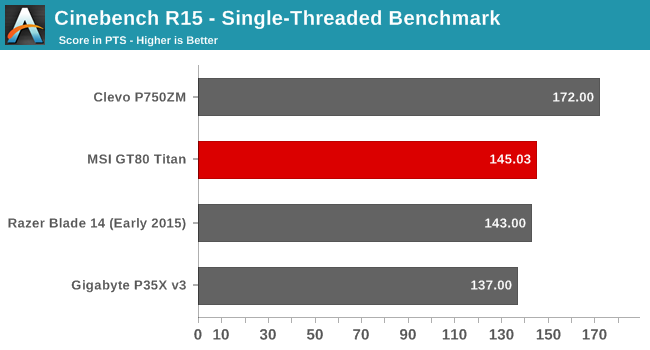
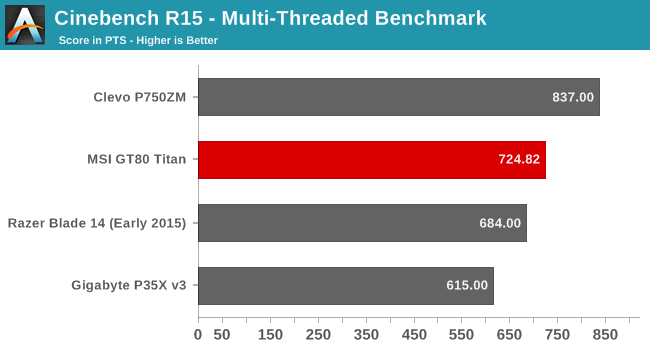
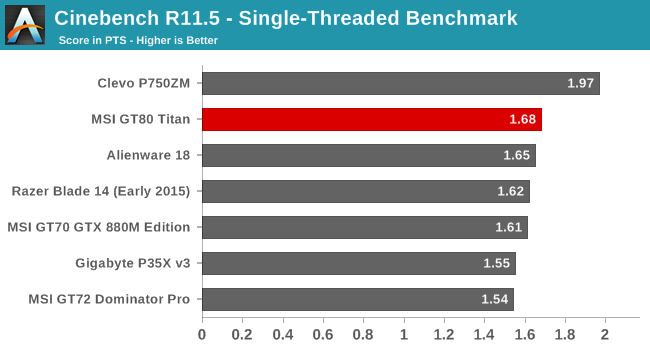
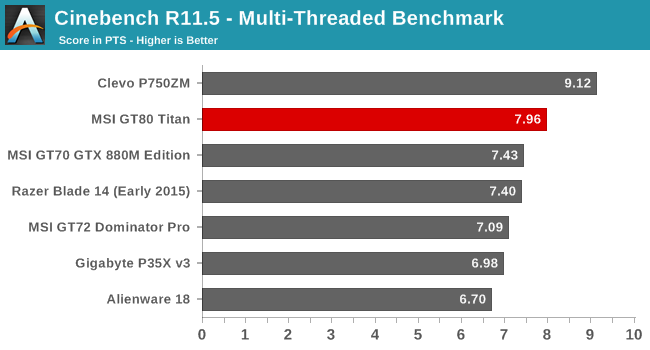
Cinebench is more of a pure CPU test, and it favors high frequencies and IPC. Here we get a better feel for Broadwell and the i7-5700HQ performs very well. It outperforms all of the other 47 watt processors we have tested despite not having the highest turbo frequency.
x264
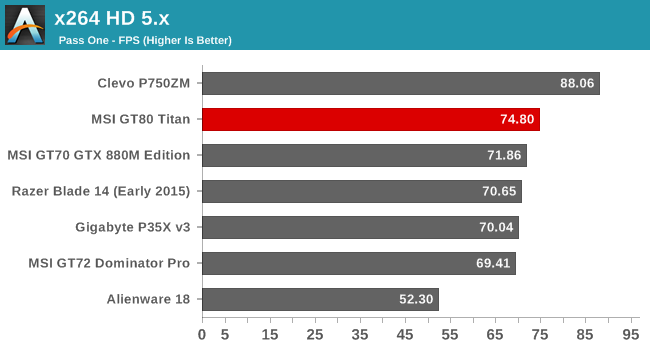
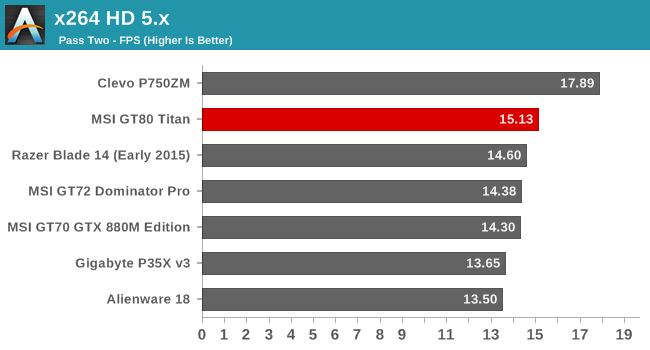
Once again, the i7-5700HQ outperforms all other 47 watt parts although it can’t compete with the 88 watt P750ZM. The move to 14nm clearly opens up some additional headroom to keep the turbo frequencies up.
Web Tests
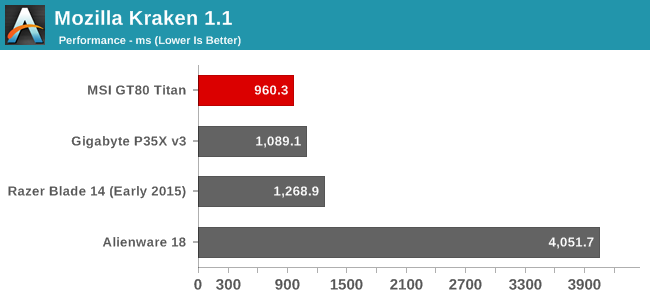

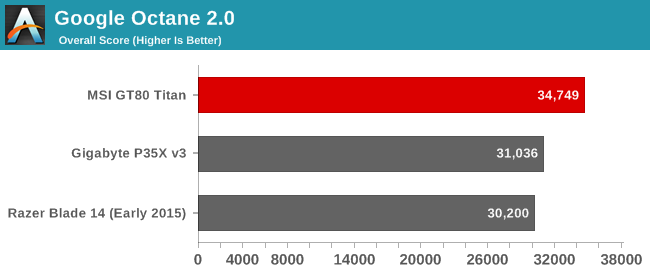
Our web tests continue the trend that has already been set. Once again the GT80 Titan sets the standard, and is only trumped by a notebook with a desktop processor.
Broadwell may just be a die shrink of Haswell, but the 14nm process is very effective. Despite having a maximum frequency of just 3.5 GHz, the i7-5700HQ outperforms Haswell parts that can turbo up a few hundred megahertz more, which is pretty impressive.










103 Comments
View All Comments
Laststop311 - Friday, June 26, 2015 - link
Man imagine if they would of put a 120 or 144hz panel on this thing. That woulda just rly took it to another level considering it's easily hitting 120 fps+ on games.dali71 - Saturday, June 27, 2015 - link
I'm considering getting a Eurocom X8 for exactly that reason. It's ridiculous to give a laptop that much GPU power, only to cripple it with a 60Hz display.meacupla - Friday, June 26, 2015 - link
"MSI includes a wrist rest in the box which mounts on the front."Are there any pictures of said wrist rest being attached to the laptop?
I mean, I know it's an accessory and all, but if it's a laptop that comes with external accessories, it'd be nice to see the size of all accessories that come with the retail box the laptop came in.
For example, the power brick that came with the initial Xbox 360 was MASSIVE and that added a lot of bulk to the entire package, especially if you wanted to take it over to a friend's house.
JKflipflop98 - Friday, June 26, 2015 - link
I think the power numbers are quite misleading. Why don't you try doing what this laptop is built for and see how long the battery lasts? I didn't see any charts with battery life while actually using those two Titans. I'd wager you get 20 minutes of battery life before you need to plug in again.Notmyusualid - Saturday, June 27, 2015 - link
Having had a string of DTR machines to my name, I can say that gaming tends around the 60 minute mark on battery.The battery ends up being a UPS to most of the machines I've had, but the M18xR2 I have has HD4000 graphics, and I can run for hours using that, but annoyingly, it requires a reboot to activate, and thus gets little real world use.
bennyg - Sunday, June 28, 2015 - link
Most gaming notebooks downclock on battery, too much current draw will overheat the battery. You just do not bother gaming on battery. The strength of this is that you're not tethered to your desk. Though... while not less hassle, it is probably a lot cheaper to just buy 2 desktops of similar power :oSirGCal - Friday, June 26, 2015 - link
If this had G-Sync to the monitor and an M2 PCIe slot for faster still performance storage, I'd buy it in a second... So close though!Laststop311 - Friday, June 26, 2015 - link
Does this laptop use pci-e ssd's? I have a feeling it doesn't since the 2 gpu's will be eating up 16 pci-e lanes. We have to wait for skylake for the 4 extra pci-e lanes from the cpu before we can have sli graphics and pci-e ssd's.Even so I am extremely impressed with this laptop. I truly hope MSI keeps this design going when skylake is released. If MSI releases this exact laptop with skylake and uses the extra pci-e lanes from skylake for pci-e ssd's I will be buying this to replace my m18x. Nothing beats a large 18 inch laptop for portable lan gaming. With this laptop since the keyboard is so nice you don't even need to pack a keyboard and monitor with you when you go. I currently have to carry a keyboard and 24 inch monitor with me as well as the notebook and mouse. With this design all I need is the notebook and mouse.
My wish is they keep this exact same design when skylake comes out and add the option of a XM overclockable skylake flagship mobile cpu so I can overclock it to a solid 4.3-4.5ghz similar to how i overclock the 2960xm to 4.2ghz in my alienware. And use the 4 extra pci-e lanes to make one of the m2 slots a pci-e 3.0 x4 slot and the other one a normal sata slot. If they make this simple tweak I will be buying on day 1.
dominiqueovalle - Saturday, June 27, 2015 - link
when will the anandtech review for the 1080p razer blade come out? if everMamiyaOtaru - Saturday, June 27, 2015 - link
would have preferred a physical numpad. What about cursor control? eh, trackpoint maybe? I'd expect an external mouse to be in use most of the time, and a trackpoint would be fine for backup